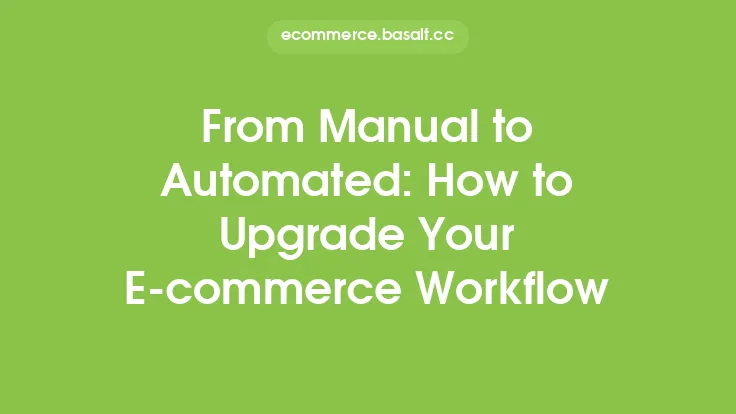In the world of e-commerce, managing a successful online store can be a daunting task. From processing orders and handling customer inquiries to managing inventory and shipping, the workload can be overwhelming. However, with the advent of automation technology, e-commerce businesses can now simplify their workflow, increase efficiency, and reduce costs. Automation has become an essential tool for e-commerce companies, enabling them to streamline their operations, improve customer satisfaction, and stay competitive in a rapidly evolving market.
Introduction to E-commerce Automation
E-commerce automation refers to the use of technology to automate repetitive and mundane tasks, freeing up time and resources for more strategic and creative endeavors. By automating tasks such as order processing, inventory management, and shipping, e-commerce businesses can reduce the risk of human error, increase productivity, and improve overall efficiency. Automation can be applied to various aspects of e-commerce, including customer service, marketing, and fulfillment, making it an indispensable tool for online retailers.
Benefits of Automation in E-commerce
The benefits of automation in e-commerce are numerous. For one, automation can help reduce labor costs by minimizing the need for manual labor. Automated systems can process orders, handle customer inquiries, and manage inventory with greater speed and accuracy than human employees. Additionally, automation can help improve customer satisfaction by providing faster and more efficient service. Automated systems can respond to customer inquiries 24/7, reducing wait times and improving overall customer experience. Automation can also help e-commerce businesses scale more efficiently, enabling them to handle increased traffic and sales without sacrificing quality or service.
Types of Automation in E-commerce
There are several types of automation that can be applied to e-commerce, including:
- Order automation: automating the order processing and fulfillment process to reduce errors and increase efficiency.
- Inventory automation: automating inventory management to ensure accurate tracking and reporting of stock levels.
- Shipping automation: automating the shipping process to reduce costs and improve delivery times.
- Customer service automation: automating customer service to provide faster and more efficient support.
- Marketing automation: automating marketing campaigns to improve targeting and conversion rates.
Implementing Automation in E-commerce
Implementing automation in e-commerce requires careful planning and execution. The first step is to identify areas of the business that can be automated, such as order processing or inventory management. Next, e-commerce businesses must choose the right automation tools and software to meet their needs. This may involve integrating multiple systems and platforms to create a seamless and efficient workflow. Finally, e-commerce businesses must train their staff to use the new automated systems and monitor their performance to ensure they are working effectively.
Best Practices for E-commerce Automation
To get the most out of automation, e-commerce businesses should follow best practices such as:
- Start small: begin with a small pilot project to test the effectiveness of automation before scaling up.
- Choose the right tools: select automation tools and software that meet the specific needs of the business.
- Monitor performance: regularly monitor the performance of automated systems to ensure they are working effectively.
- Train staff: provide training and support to staff to ensure they can use automated systems effectively.
- Continuously evaluate and improve: continuously evaluate and improve automated systems to ensure they remain effective and efficient.
Common Challenges and Limitations
While automation can bring numerous benefits to e-commerce businesses, there are also common challenges and limitations to consider. One of the main challenges is the initial investment required to implement automation, which can be costly. Additionally, automation may require significant changes to business processes and workflows, which can be time-consuming and disruptive. Furthermore, automation may also require ongoing maintenance and updates to ensure it remains effective and efficient. Finally, automation may not be suitable for all aspects of e-commerce, such as tasks that require human judgment or creativity.
Future of E-commerce Automation
The future of e-commerce automation is exciting and rapidly evolving. With the advent of new technologies such as artificial intelligence and machine learning, automation is becoming increasingly sophisticated and effective. In the future, we can expect to see even more advanced automation tools and software that can learn and adapt to the needs of e-commerce businesses. Additionally, the use of automation in e-commerce is likely to become even more widespread, enabling businesses to streamline their operations, improve customer satisfaction, and stay competitive in a rapidly evolving market.
Conclusion
In conclusion, automation is a powerful tool that can simplify and streamline e-commerce workflow, improving efficiency, reducing costs, and enhancing customer satisfaction. By understanding the benefits and types of automation, implementing automation effectively, and following best practices, e-commerce businesses can unlock the full potential of automation and stay ahead of the competition. As the e-commerce landscape continues to evolve, automation will play an increasingly important role in enabling businesses to succeed and thrive.





